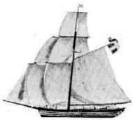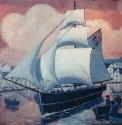|
|
|
|
|||
|
A recent sloop "Restauration" painting by Norwegian artist Geir Bjoergum; used with permission. |
The Norwegian Sloop "Restoration"Sluppen «Restauration»"The Norwegian Mayflower" |
|
|
|
|
|||
|
A recent sloop "Restauration" painting by Norwegian artist Geir Bjoergum; used with permission. |
.
A Sloop is "a fore-and-aft rigged boat with one mast and a single headsail jib,"
according to Webster. (For more definitions CLICK HERE.)
In July 1825 the small Norwegian sloop Restoration sailed from southwest Norway with 52 emigrants, most of whom were seeking religious freedom.
The Restoration is often called the "Norwegian Mayflower."
Passengers on this sloop and their descendants are often called the "Sloopers" ("sluppfolket" in Norwegian) No photographs of this historic ship exists. On this page, we will attempt to collect information on, and graphic representations of, the Restoration and similar vessels.
A description of the sloop Restoration from the Slooper book 1
The Sloop was built in Hardanger in 1801 and was originally 6 commercial lasts or 12.48 tons burden. It carried herring to Gothenburg in Sweden and returned with grain from Denmark. It was first called Emanuel and later on, Håbet. In the 1820 Håbet had been enlarged and rebuilt in Egersund so that its burden became 18½ commercial lasts (or 38.48 tons) according to a certificate of measure dated at Egersund Oct. 5, 1820. The Sloop was then 54 feet long and 16 feet broad and drew 7½ feet of water. To commemorate its rebuilding a new name, Resturasjonen, i.e. "the Restoration," was painted on in Egersund Feb. 5, 1820. (pp. 15-16)
Berths had to be built for all of them (52 persons) on the lower deck... The deck area.., allowing for the flare of the ship, could not have been more than 480 square feet, about 9 square feet per person. Assuming a minimum of space between bunks and tiniest of companionways, only 250 square feet was available for sleeping. Even with double bunks this was less than two-thirds the room needed, for 2½ by 6 foot bunks for all of the immigrants. Besides, space had to be provided for the chests containing their possessions and provisions. (p. 18)
On deck there was an abundance of fresh air but scarcely more room. The total area was only about 670 square feet. Allowing space for the galley, the companionway, water tanks, and lockers for fuel, sails, ropes, and the like, approximately 560 square feet remained for the 52 passengers. (p. 28)
.
"The Sloop was 2½ times as crowded as the Mayflower."
The Mayflower weighed 180 tons; was 90' long, 26' wide & at least twice as high as the Sloop (pp. 16, 18)
"According to American Law, a ship with 46 passengers (52 less crew) had to be at least 115 reg. tons to cross the Atlantic. The «Restauration» was only 38 reg. tons. Therefore, the authorities fined the group for overloading the ship. But after a petition to president John Quincy Adams, the case was dropped and the ship with its cargo was sold for 400 dollars."2
Another version of Restoration's history available online 3
"In the different sources we find several ways of spelling the name of this ship, like Restauration, Restoration, Restaurasjonen and Restorasjon. ... The Restaurasjonen was a small sloop, or as it is called in Norway 'Hardanger Jakt'. She was built in Hardanger in 1801 as the 'Emanuel', but was renamed 'Haabet' (Hope) probably in 1815. The sloop was used for freighting herring and corn. In 1820 she was rebuilt and renamed 'Restaurasjonen' (Restoration)."
Are sloops and Hardanger jakts the same?
On a Certificate of Authenticity 4 for a wooden half model of the Restauration there are indications that these two types of vessels are technically not quite the same. This certificate indicates that the sloop Restauration was a "rebuilt Hardangerjakt." It further states that,
"The 'Hardangerjakt' was a small, decked sailing ship, cravel-constructed with a square transom. Several hundred of these small ships sailed in the Norwegian merchant marine during the 19th century. For the most part they sailed in the coastal trade, but they also made occasional voyages to North Sea ports and the Baltic. At that time they often carried herring and other fish on their passage from Norway and rye and other grains going home."
In distinction, the certificate then states,
"Sloops usually had narrower hulls than the 'jakt,' they had a larger overhang aft and a relatively straight stern. The 'jakt' usually had a mast made from one tree, the sloops usually set a mainmast with a topmast."
|
|
An expert's opinion from Norway In an e-mail received from Harald Hamre, curator at the Stavanger Maritime Museum on 19 June 2003, Mr. Harmre stated: "I've visited your homepage and as far as I can see, you've already collected the most relevant information about the 'Restauration'. The problem with all images is that nobody knows exactly how she looked. The terms "slupp" and "jakt" were often mixed during the first decades of 19th century. Tradisionally a "jakt"s mast would be in one piece, the "slupp" would have a topmast." |
|
|
--- Presently unavailable in English ---
|
A similar vessel
See the Wheeler's photo album #15 from the July 4, 2000, Stavanger Emigration Festival, which includes photos of the sloop Anna of Sand. Built around 1848, it is one of Europe's oldest vessel still afloat and is owned by the Stavanger Maritime Museum. She measures about 52 feet long and 18 feet wide. The Anna of Sand is considered to be very close to the same size and configuration as the Restoration and is used in Norwegian pageants to portray the Restoration. It is believed that the Restoration had "one board higher freeboard" than the Anna of Sand.
Sources:
The Sloopers; Their Ancestry and Posterity; The Story of the People on the Norwegian Mayflower -- The Sloop, "Restoration," by J. Hart Rosdail, pub. by Norwegian Slooper Society of America, 1961.
From the certified write-up on back of the wooden half model plaque from the Norwegian Emigration Center, Stavanger, Norway. See Album of Sloop Images.
From The Sloopers - pioneers in Norwegian emigration page on the "Norway-Heritage; Hands Across the Sea" web site, one of the best Slooper/Restoration Internet pages (see also Sloop Restaurasjonen page.
Graciously furnished by Eivind Helle of Scandinavian Heritage.
Other web sites with reference to, and/or photos of, the Restoration, Anna af Sand or Norwegian sloops in general:
The Promise of America homepage with Blessum's 1914 painting:
http://www.nb.no/emigrasjon/emigration/
Also from their "Photos & Prints" collection is an excellent image of the Restoration from Norsk Utvandrermuseum
Hardanger jakt, Mathilde, from the Hardanger Fartøyvernsenter (old boat museum)
http://www.museumsnett.no/hfs/eng/segling/index.html (click on "Mathilde-facts")
Originally built as a Hardanger-jakt in 1889, the Svanhild later was rigged as a 2-master.
Send us your recommendations?
... ![]()
Intro-Index Background The Sloop The Project Time Line Endorsements Maps Photos Slooper Links




Visitor
since May 6, 2003